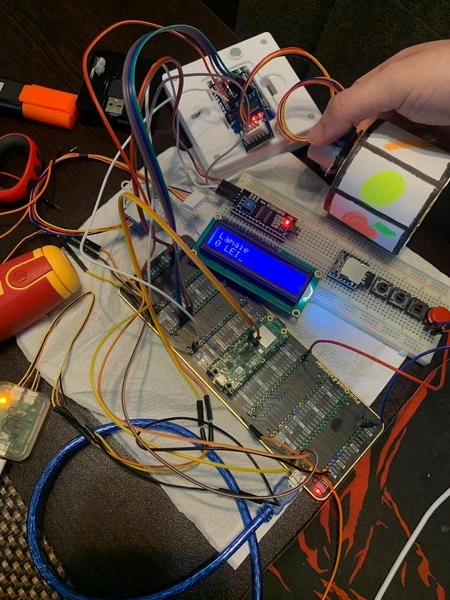Mini Slot Machine
A miniature slot machine inspired by early electromechanical casino models.
Author: Androne Andrei
GitHub Project Link: https://github.com/UPB-PMRust-Students/proiect-andronedrei
Description
This demonstrative project functions around a Raspberry Pi Pico 2W. It drives three mechanical reels with stepper motors, plays sounds through a DFPlayer Mini, shows doubling process with leds, and displays live game information on a 1602 LCD. Software is implemented using Embassy and Rust.
Motivation
Nowadays, gambling has become an unhealthy addiction for many people, so I wanted to build a project that showcases how slot machines work today. Ever since most slot machines became fully electronic, the outcome of each game has been largely determined by the underlying software. Therefore, I created a machine that lets the user choose between two game modes (Fair – completely random; Unfair – large losses that generally do not create the same addictive behaviour).
Alongside its educational purpose, the project utilizes several elements such as UART communication for the MP3 player, I2C for the screen, and the Rust code needed to implement the two game modes.
Architecture

Raspberry Pi Pico W 2 - RP2350
Role: Central component; controls everything else.
Mini MP3 player
Role: Provides music and sound effects, communicating with the Pico via UART and using its internal DAC to drive the small 2 W speaker.
Small speaker
Role: Effectively propagates the audio output from the sound module.
Step Motor 5V with Driver
Role: Spins the reels; communicates with the Pico through a ULN2003 driver using parallel transmission.
Small LCD screen with I2C adapter for easier communication
Role: Displays live game elements and allows the user to view selectable options.
Buttons
Role: Used for selecting options or for activating the spin and doubling features during gameplay.
Leds
Role: A pair of bi‑colour LEDs (simulating card‑colour betting) used for the gain‑doubling option if the player desires.
Log
Week 5 - 11 May
I bought all the necessary components and started testing the crates I can use in development. I also crafted some of the structural parts of my project, such as a slot machine wheel.
Week 12 - 18 May
I created custom structures to improve abstraction. I developed a system for precise control of the stepper motor’s rotation. I also built the initial phase of the project, which includes the connected wheel, spin button, and a screen to display income during play. I created the first part of the algorithms that simulate the game mechanics.

( See the link at the end of the page for further demonstration )
Week 19 - 25 May
Finished the project code, implementing the device at a high level as a state machine. Updated building components such as audio, bet LEDs, and random behavior. Also constructed a nice case to properly fit everything.

Hardware
The electronics are simple and modular, centred on one Raspberry Pi Pico W:
Reels – Three 28BYJ‑48 stepper motors spin the reels through ULN2003 driver boards. The Pico sends signals and stops exactly on the right symbol.
Sound – A DFPlayer Mini holds MP3 files on a micro‑SD card. The Pico tells it what to play over UART (it just sends a number of the respective sound effect index). A small 2W speaker propagates the audio.
Display – A1602 LCD with a PCF8574 I2C backpack shows credits, mode, and symbols.
Controls – Three push‑buttons (2 for game control, one for reset) give input. Two bi‑colour LEDs flash alternatively in fast succesion to allow for betting on colour.
Power – Everything apart from motors runs from a 5 V USB supply (motors are powered separately). The Pico makes its own 3.3 V for logic.
Schematics
Bill of Materials
| Device | Usage | Price |
|---|---|---|
| 1x Raspberry Pi Pico 2 W | Microcontroller | 40 RON |
| 1x Raspberry Pi Debug Pro | Debug Probe | 62 RON |
| 1x Raspberry Expansion Board | Quad Expander Board | 80 RON |
| DFPlayer Mini | MP3 Mini Player | 14 RON |
| 50mm Speaker - 2W - 32ohm | Generic Mini Speaker | 5 RON |
| 1602A | LCD display | 29 RON |
| IO PCF8574 | Expansion module for Screen's I2C communication | 9 RON |
| 3x 28BYJ-48 5V + 3x ULN2003 | Step Motor + Driver | 51 RON |
| 2GB MicroSD Card | Card for storing sounds effects | 20 RON |
| Breadboard Power Supply | Component used for powering motors separately | 6 RON |
| Minor Components (buttons, wires, leds, battery, etc.) | Taken from an Arduino Starter Pack | - |
Software
| Library | Description | Usage |
|---|---|---|
| embassy‑executor | async runtime | Runs cooperative tasks on the Pico |
| embassy-time | timers within async developement | Different pauses |
| embassy-rp | RP2350 hardware abstraction | GPIO, UART, I2C, etc. |
| dfplayer-async | crate for use of DFPlayer through UART | Music player in my project |
| lcd1602-diver | lcd1602 communication | LCD Screen with a PCF I2c expander |
| rand_pcg | random elements | Used in software part that controls game flow |
